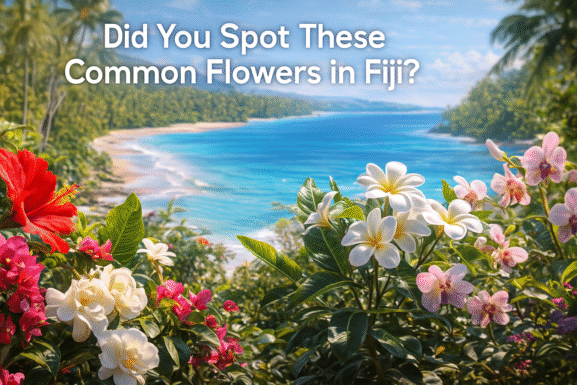Have You Seen These Fiji Man-Made Attractions?
Think of Fiji for a second. You probably see the postcards — the leaning palms, the glassy water, the kind of green that almost doesn’t look real. And that’s true enough. But there’s also a side of Fiji most travelers miss — a quieter one, built not by waves or wind, but by people and their stories. These are the Fiji man-made attractions that show how the spirit of the islands runs deeper than the coastline.
Wandering through them feels like flipping through Fiji’s memory — the old and the new sitting side by side. You’ll find sacred temples, sleepy villages, movie-famous islands, and even resorts that somehow balance luxury with tradition. And after a while, you start to see it: Fiji isn’t just beautiful, it’s expressive. It’s alive with art, belief, and craft.
Among the most fascinating Fiji man-made attractions are the ones rooted in faith and tradition.
The Spiritual Heart: Sri Siva Subramaniya Temple
In the middle of Nadi, there’s this temple you just can’t ignore. The Sri Siva Subramaniya Temple. It’s tall, painted in every color you can imagine. They say it’s the biggest Hindu temple in the Southern Hemisphere — maybe so, but that’s not the first thing that grabs you. It’s the color. The detail. The way everything seems to tell a story.
It’s built in the Dravidian style from South India, and you can spot that right away. The tall tower at the entrance, the bursts of paint, the carvings of gods and goddesses climbing up the walls — it’s all there. All the carvings were done by hand — real people, real tools, brought in from India just for this. Look closely and you can tell.
Inside, it smells like incense. A bell rings somewhere. It’s peaceful, but not the kind of quiet you get in empty places — more like everything’s alive, just slow. And in that moment, you can feel how many cultures have built this country together.
A Walk Through Time: The Fiji Museum
To understand how creative Fijians have always been, you have to dig into their history — and the Fiji Museum in Suva is the perfect place to do that. In the shade of Thurston Gardens sits a quiet colonial building filled with stories from every corner of Fiji’s past.
There are old tools and weapons inside, and even the rudder from the HMS Bounty — yeah, that famous ship from the 1789 mutiny. Still, the best part’s the handmade stuff: the carved war clubs, the fancy cannibal forks, and the drua canoes that once ruled the ocean.
They don’t feel like museum objects. They feel like proof — that long before modern Fiji, creativity and skill were already a way of life. Walking through, it’s easy to see how that same spirit still runs through the islands today.
Some Fiji man-made attractions tell their stories through architecture — old buildings that hold echoes of history right beside symbols of progress
Old Charm and Modern Pride: The Grand Pacific Hotel and Parliament Complex
Fiji’s got its history written in its buildings too. In Suva, the Grand Pacific Hotel and the Parliament Complex sit almost side by side — like two pages from completely different chapters.
Locals call it the GPH. It opened way back in 1914, when people still showed up by steamship, not by plane. They’ve fixed it up over the years, sure, but the feeling hasn’t gone anywhere. You walk through and still catch the same old charm — white walls, long verandas, that quiet kind of grace that just feels real.
Just a short walk away, the Parliament Complex represents a more modern Fiji. Its buildings are modeled after traditional Fijian structures, complete with a giant yavu (foundation stone). It feels grounded in tradition but built for the present — a beautiful symbol of how Fiji has moved from colonial rule to independence while keeping its roots close.
The Magic of Monuriki and Castaway Island, Fiji
Then there’s Monuriki — a tiny, empty island that suddenly got famous after Cast Away was filmed there back in 2000 with Tom Hanks. Though completely natural, it’s now forever tied to a man-made story — one about survival and solitude that captured millions.
Today, visitors come to see the exact beach where the film was shot and the cave where the character Chuck Noland lived. The island itself remains untouched, wild, and stunning — its fame just adds another layer to its charm.
There’s also Castaway Island Resort, over on another island in the Mamanuca group. It’s got all the comfort in the world, but somehow it keeps that simple, relaxed feel. The thatched bures, the open-air spots to eat — everything blends right into the island. It’s built by people, sure, but with a lot of heart for the land it sits on.
Where Culture Lives: The Arts Village
If you really want to see Fiji’s culture, not just read about it, go to the Arts Village in Pacific Harbor. It’s not a museum. It’s alive. Things are happening around you — noise, color, movement.
People are weaving mats, carving tanoa bowls, and shaping pottery. You can walk right up, watch their hands, and maybe ask a question. Sometimes you’ll catch a meke — a dance where stories unfold through song and rhythm. It hits deep, raw, and emotional.
But what really stays with you is how you don’t feel like a visitor at all. You feel included, even for a short while. The Arts Village shows how Fijian creativity isn’t something from the past — it’s still here, breathing and changing with every generation.
More Than Just a Paradise
Everyone knows about the beaches — and honestly, they live up to the hype. But that’s just one side of Fiji.
What gives the islands their soul is the people, and what they’ve made over time.
From the colorful carvings of the Sri Siva Subramaniya Temple to the quiet rooms of the Fiji Museum, from Suva’s old hotel verandas to the living crafts of the Arts Village, these man-made attractions capture the islands’ creative heartbeat.
And for something truly cinematic, places like Castaway Island Fiji remind visitors that even film locations can become part of the islands’ cultural story.
So if you ever visit, go past the resorts. Walk the towns. Step into a temple. Stop and watch someone working — maybe carving wood, maybe weaving a mat.



